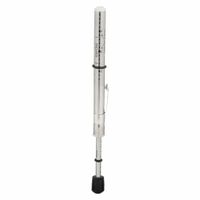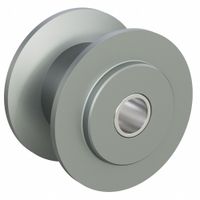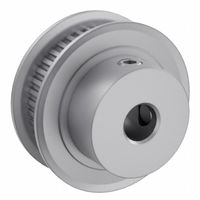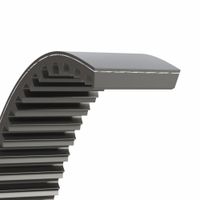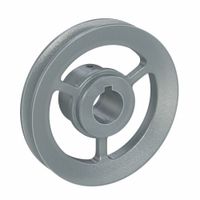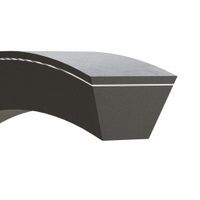Call +(254) 703 030 000 / 751 483 999 / 721 704 777
- Home
- Power Transmission
- Belts Pulleys
.....Read More
Frequently Asked Questions
What are the main types of power transmission belts?
The main types of power transmission belts are:
1. **Flat Belts**: These are simple, flat, and flexible belts used for moderate power transmission. They are typically made of leather, rubber, or fabric and are suitable for long-distance power transmission. Flat belts are known for their efficiency and ability to operate at high speeds.
2. **V-Belts**: These belts have a trapezoidal cross-section, which allows them to fit into the grooves of V-belt pulleys. They are widely used in industrial applications due to their ability to transmit higher power and their resistance to slipping. V-belts are available in various sizes and are classified into sections like A, B, C, D, and E, based on their dimensions.
3. **Synchronous Belts (Timing Belts)**: These belts have teeth on the inner surface that mesh with the corresponding grooves on the pulleys, ensuring a positive drive without slippage. They are used in applications where precise timing and synchronization are crucial, such as in automotive engines and machinery.
4. **Round Belts**: These belts have a circular cross-section and are typically used in low-power applications. They are made from materials like rubber or polyurethane and are often used in light-duty applications such as small machinery and appliances.
5. **Multi-Ribbed Belts (Poly-V Belts)**: These belts combine the features of flat and V-belts, having multiple small V-shaped ribs running along the length of the belt. They provide high power transmission efficiency and are used in applications requiring compact design and high-speed operation.
6. **Link Belts**: These are made of removable links that can be adjusted to the desired length. They are used in applications where quick installation and maintenance are required, offering flexibility and ease of use.
Each type of belt is selected based on factors like power transmission requirements, speed, distance, and environmental conditions.
How do V-belts and pulleys work together in a drive system?
V-belts and pulleys work together in a drive system to transmit power efficiently between rotating shafts. The V-belt, named for its trapezoidal cross-section, fits into the V-shaped grooves of the pulley. This design increases friction and grip, reducing slippage and enhancing power transmission.
When the drive pulley, connected to a power source like an engine or motor, rotates, it moves the V-belt. The belt, in turn, rotates the driven pulley, transferring mechanical energy to the connected machinery. The tension in the belt, maintained by adjusting the distance between pulleys or using tensioners, ensures effective power transfer and minimizes belt wear.
The V-belt's flexibility allows it to absorb shock loads and dampen vibrations, protecting the drive system components. The pulleys' alignment is crucial; misalignment can cause uneven wear, noise, and reduced efficiency. V-belts are available in various sizes and materials, allowing customization for specific applications, from light-duty to heavy industrial use.
Overall, the V-belt and pulley system is a simple, cost-effective solution for power transmission, offering reliability and ease of maintenance.
What are the advantages of using timing belts over other types of belts?
Timing belts offer several advantages over other types of belts, such as V-belts or flat belts:
1. **Precision and Synchronization**: Timing belts are designed with teeth that mesh with the grooves on the pulleys, ensuring precise timing and synchronization between the driving and driven components. This is crucial in applications like automotive engines, where accurate timing of the camshaft and crankshaft is essential.
2. **No Slippage**: The toothed design of timing belts prevents slippage, maintaining consistent speed and torque transmission. This is particularly beneficial in applications requiring exact positioning and speed control.
3. **Low Maintenance**: Timing belts generally require less maintenance compared to chain drives, as they do not need lubrication. This reduces downtime and maintenance costs.
4. **Quiet Operation**: Timing belts operate more quietly than chain drives, making them suitable for applications where noise reduction is important, such as in office machinery or home appliances.
5. **Efficiency**: Timing belts have a high efficiency rate, often exceeding 95%, due to their positive engagement with the pulleys. This results in less energy loss compared to friction-based belt systems.
6. **Durability and Longevity**: Made from materials like rubber, polyurethane, or neoprene reinforced with fibers such as fiberglass or Kevlar, timing belts are durable and resistant to wear, heat, and chemicals, extending their service life.
7. **Compact Design**: Timing belts allow for more compact and lightweight designs, as they can operate effectively with smaller pulleys and require less tension than other belt types.
8. **Versatility**: They are suitable for a wide range of applications, from automotive engines to industrial machinery, due to their ability to handle various loads and speeds.
Overall, timing belts provide reliable, efficient, and low-maintenance solutions for applications requiring precise timing and synchronization.
How do you determine the correct size of a V-belt for a pulley system?
To determine the correct size of a V-belt for a pulley system, follow these steps:
1. **Identify Belt Type**: Determine the type of V-belt needed (e.g., classical, narrow, or fractional horsepower) based on the application and power requirements.
2. **Measure Pulley Diameters**: Measure the diameters of both the driver and driven pulleys. This helps in calculating the belt length and ensuring compatibility with the pulleys.
3. **Determine Center Distance**: Measure the center distance between the driver and driven pulleys. This is crucial for calculating the belt length.
4. **Calculate Belt Length**: Use the formula for belt length:
\[ L = (2 \times C) + \left(\frac{\pi \times (D + d)}{2}\right) + \left(\frac{(D - d)^2}{4 \times C}\right) \]
where \( L \) is the belt length, \( C \) is the center distance, \( D \) is the diameter of the larger pulley, and \( d \) is the diameter of the smaller pulley.
5. **Select Belt Cross-Section**: Choose the appropriate belt cross-section (e.g., A, B, C, D) based on the power transmission requirements and pulley groove dimensions.
6. **Check Belt Tension**: Ensure the belt tension is appropriate for the application. Proper tension is crucial for efficient power transmission and belt longevity.
7. **Consult Manufacturer Specifications**: Refer to manufacturer catalogs or specifications to match the calculated belt length and cross-section with available belt sizes.
8. **Consider Environmental Factors**: Account for environmental conditions such as temperature, humidity, and exposure to chemicals, which may affect belt material and performance.
9. **Verify Alignment**: Ensure pulleys are properly aligned to prevent premature belt wear and ensure efficient operation.
By following these steps, you can accurately determine the correct size of a V-belt for your pulley system, ensuring optimal performance and longevity.
What are the common causes of belt slippage and how can it be prevented?
Common causes of belt slippage include:
1. **Improper Tension**: If a belt is too loose, it can slip off the pulleys. Conversely, excessive tension can cause wear and tear.
2. **Misalignment**: Misaligned pulleys can cause the belt to slip off or wear unevenly.
3. **Wear and Tear**: Over time, belts can become worn, cracked, or glazed, reducing their grip.
4. **Contamination**: Oil, grease, or other contaminants on the belt or pulleys can reduce friction and cause slippage.
5. **Overloading**: Exceeding the belt's load capacity can lead to slippage.
6. **Incorrect Belt Size**: Using a belt that is too large or too small can cause improper fit and slippage.
Prevention methods include:
1. **Regular Maintenance**: Regularly inspect belts for signs of wear and replace them as needed.
2. **Proper Tensioning**: Use a tension gauge to ensure the belt is at the correct tension.
3. **Alignment Checks**: Regularly check and adjust pulley alignment to ensure they are parallel and in the same plane.
4. **Cleanliness**: Keep belts and pulleys clean and free from contaminants.
5. **Correct Sizing**: Ensure the correct belt size and type are used for the application.
6. **Load Management**: Avoid overloading the belt beyond its capacity.
7. **Use of Belt Dressings**: In some cases, applying a belt dressing can improve grip and reduce slippage.
By addressing these factors, belt slippage can be minimized, ensuring efficient operation and prolonging the life of the belt system.
How do you maintain and extend the life of power transmission belts?
To maintain and extend the life of power transmission belts, follow these key practices:
1. **Proper Installation**: Ensure correct alignment and tension during installation. Misalignment can cause uneven wear, while improper tension can lead to slippage or excessive strain.
2. **Regular Inspection**: Conduct routine checks for signs of wear, such as fraying, cracking, or glazing. Early detection of issues can prevent further damage.
3. **Correct Tensioning**: Use a tension gauge to maintain optimal tension. Over-tensioning can cause stress and premature failure, while under-tensioning can lead to slippage and inefficiency.
4. **Alignment Checks**: Regularly verify that pulleys are aligned. Misalignment can cause edge wear and reduce belt life.
5. **Clean Environment**: Keep the belts and surrounding area clean. Dust, oil, and debris can cause slippage and wear. Use guards to protect belts from contaminants.
6. **Proper Storage**: Store belts in a cool, dry place away from direct sunlight and chemicals. Avoid hanging belts on pegs, which can cause deformation.
7. **Use of Quality Components**: Invest in high-quality belts and pulleys. Inferior materials can wear out quickly and affect performance.
8. **Avoid Overloading**: Ensure the system is not overloaded beyond its capacity. Overloading can cause excessive heat and stress on the belts.
9. **Lubrication**: For belts that require lubrication, use the correct type and amount to reduce friction and wear.
10. **Temperature Control**: Operate within the recommended temperature range. Excessive heat can degrade belt materials.
11. **Training**: Ensure personnel are trained in proper maintenance and handling procedures to prevent accidental damage.
By adhering to these practices, you can significantly extend the lifespan of power transmission belts, ensuring efficient and reliable operation.
What is the difference between a timing belt and a V-belt?
A timing belt and a V-belt serve different functions in a vehicle's engine system.
A timing belt is a toothed belt that synchronizes the rotation of the crankshaft and camshaft(s) to ensure that the engine's valves open and close at the correct times during each cylinder's intake and exhaust strokes. It is crucial for maintaining the engine's timing and preventing the pistons from striking the valves. Timing belts are typically made of rubber with high-tensile fibers for strength and durability. They require periodic replacement to prevent engine damage due to wear or failure.
A V-belt, on the other hand, is used to transmit power from the engine's crankshaft to various auxiliary components, such as the alternator, power steering pump, water pump, and air conditioning compressor. It is called a V-belt because of its V-shaped cross-section, which fits into the grooves of pulleys. This design provides good traction and allows for efficient power transmission. V-belts are generally made of rubber and fabric, and they may need adjustment or replacement due to stretching or wear over time.
In summary, the primary difference lies in their functions: the timing belt is essential for engine timing, while the V-belt is used for driving auxiliary components. Additionally, timing belts have teeth for precise synchronization, whereas V-belts have a smooth, V-shaped design for power transmission.
How do you install a new belt on a pulley system?
1. **Safety First**: Ensure the machine is turned off and unplugged. Wear appropriate safety gear, such as gloves and safety glasses.
2. **Access the Pulley System**: Remove any covers or guards that protect the pulley system. Use appropriate tools like screwdrivers or wrenches.
3. **Release Tension**: Loosen the tensioner or adjuster to relieve tension on the old belt. This may involve loosening bolts or using a tension release lever.
4. **Remove the Old Belt**: Carefully slide the old belt off the pulleys. Note the belt's path for correct installation of the new belt.
5. **Inspect Components**: Check pulleys and tensioners for wear or damage. Replace any worn parts to ensure optimal performance.
6. **Install the New Belt**: Position the new belt on the pulleys, following the same path as the old belt. Ensure the belt is seated properly in the pulley grooves.
7. **Adjust Tension**: Tighten the tensioner or adjuster to apply the correct tension to the new belt. Refer to the machine's manual for specific tension requirements.
8. **Check Alignment**: Ensure the belt is aligned correctly on the pulleys. Misalignment can cause premature wear or belt failure.
9. **Test the System**: Manually rotate the pulleys to ensure smooth operation and proper belt tracking. Make any necessary adjustments.
10. **Reassemble and Secure**: Replace any covers or guards that were removed. Ensure all bolts and screws are tightened securely.
11. **Final Test**: Power on the machine and observe the belt in operation. Listen for unusual noises and check for proper function.
12. **Regular Maintenance**: Periodically check belt tension and condition to maintain efficiency and prolong the life of the belt and pulley system.
What are the signs that a belt or pulley needs to be replaced?
Signs that a belt or pulley needs replacement include:
1. **Visible Cracks or Fraying**: Inspect the belt for any visible cracks, fraying, or splits. These are clear indicators of wear and potential failure.
2. **Squealing or Chirping Noises**: Unusual noises such as squealing or chirping when the engine is running can indicate a misaligned or worn-out belt or pulley.
3. **Glazing or Shiny Appearance**: A belt that appears shiny or glazed on its surface may be slipping, indicating it has lost its grip and needs replacement.
4. **Excessive Wear**: Check for signs of excessive wear, such as a thinning belt or missing chunks. This can compromise the belt's performance.
5. **Vibrations or Shaking**: If you notice vibrations or shaking in the engine compartment, it could be due to a misaligned or damaged pulley.
6. **Burning Rubber Smell**: A burning rubber smell can indicate that the belt is slipping and overheating, which can lead to failure.
7. **Misalignment**: Inspect the pulleys for alignment. Misaligned pulleys can cause uneven wear on the belt and lead to premature failure.
8. **Belt Slippage**: If the belt slips off the pulleys frequently, it may be stretched or the pulleys may be worn out.
9. **Pulley Damage**: Look for any visible damage to the pulleys, such as dents, cracks, or warping, which can affect belt performance.
10. **Age and Mileage**: Consider the age and mileage of the belt. Most belts have a recommended replacement interval, and exceeding this can increase the risk of failure.
11. **Loss of Functionality**: If accessories driven by the belt, such as the alternator or power steering, are not functioning properly, it may be due to a failing belt or pulley.
How do you calculate the tension required for a belt drive system?
To calculate the tension required for a belt drive system, follow these steps:
1. **Identify Parameters**: Determine the following parameters:
- Power to be transmitted (P) in watts.
- Speed of the driving pulley (N1) in RPM.
- Speed of the driven pulley (N2) in RPM.
- Diameter of the driving pulley (D1) in meters.
- Diameter of the driven pulley (D2) in meters.
- Coefficient of friction (μ) between the belt and pulley.
- Angle of contact (θ) in radians.
- Belt velocity (V) in meters per second.
2. **Calculate Belt Velocity (V)**:
\[
V = \frac{\pi \times D1 \times N1}{60}
\]
3. **Calculate the Power Transmitted**:
\[
P = (T1 - T2) \times V
\]
Where T1 is the tension in the tight side and T2 is the tension in the slack side.
4. **Determine the Ratio of Belt Tensions**:
\[
\frac{T1}{T2} = e^{\mu \times \theta}
\]
5. **Solve for Tensions**:
Rearrange the power equation to solve for T1:
\[
T1 = \frac{P}{V} + T2
\]
Substitute the ratio of tensions:
\[
T1 = T2 \times e^{\mu \times \theta}
\]
6. **Calculate T2**:
Substitute T1 in the power equation:
\[
P = (T2 \times e^{\mu \times \theta} - T2) \times V
\]
Simplify to find T2:
\[
T2 = \frac{P}{V \times (e^{\mu \times \theta} - 1)}
\]
7. **Calculate T1**:
Use the ratio of tensions:
\[
T1 = T2 \times e^{\mu \times \theta}
\]
These calculations provide the tensions required in the belt drive system to transmit the specified power efficiently.
